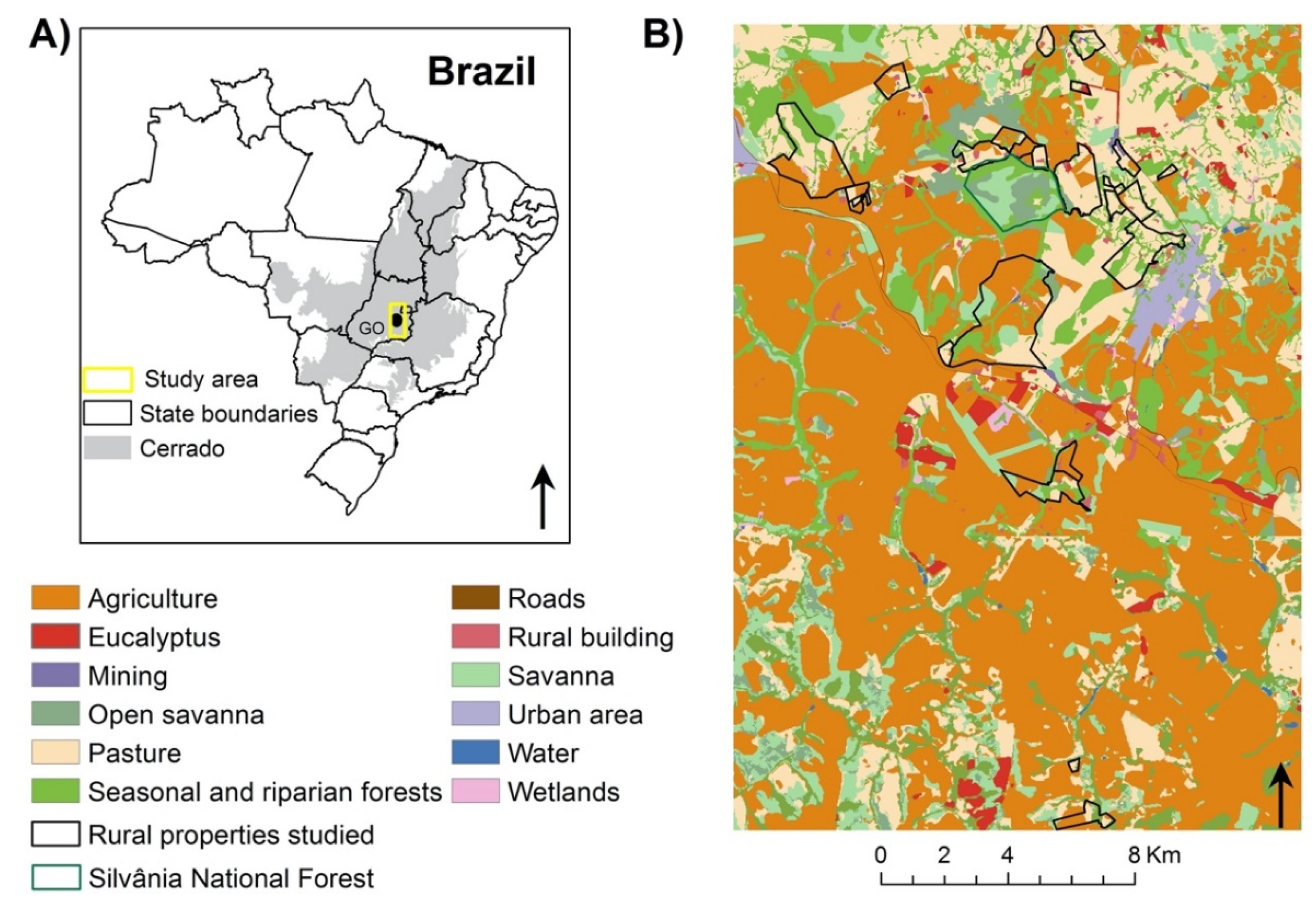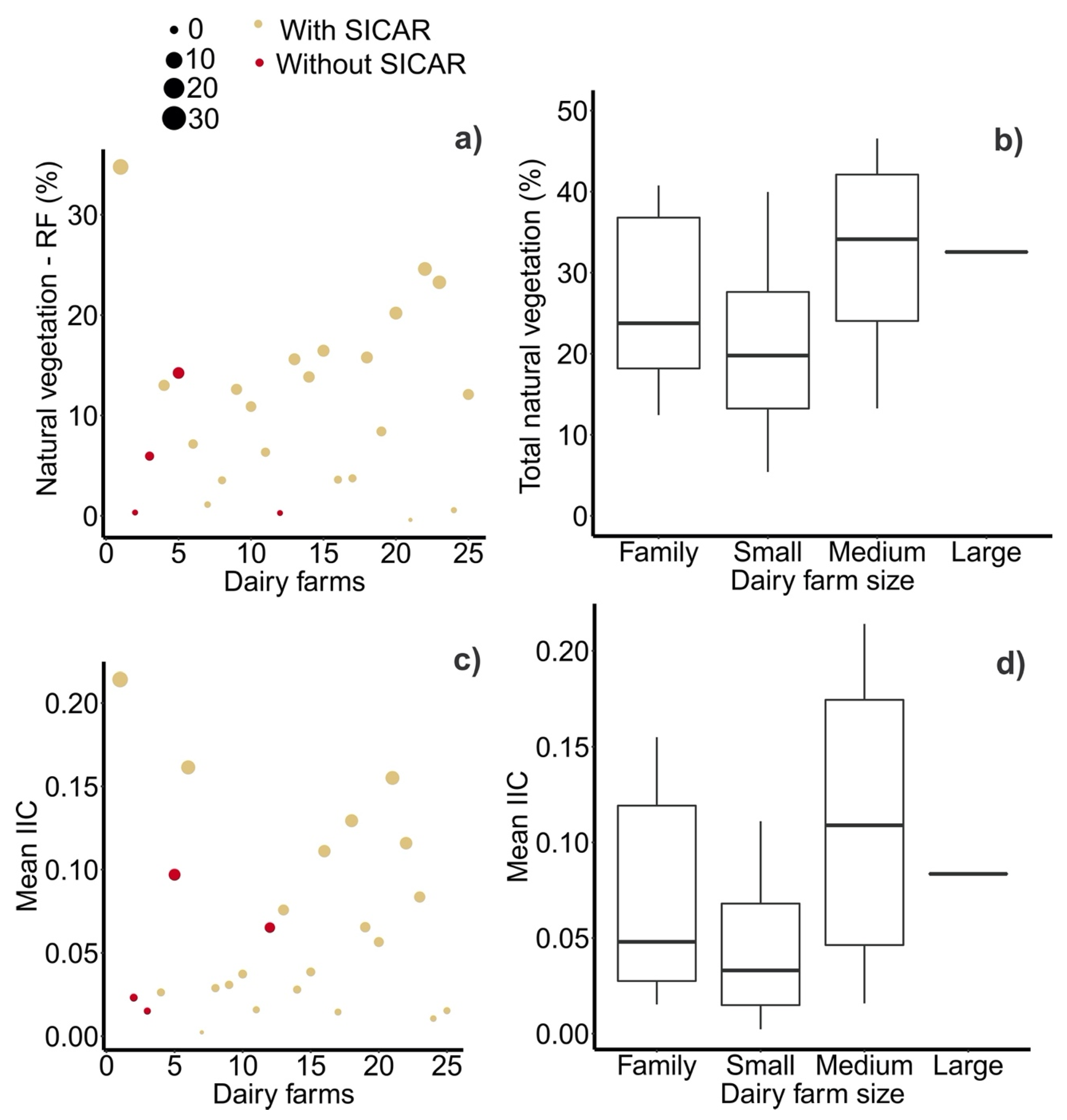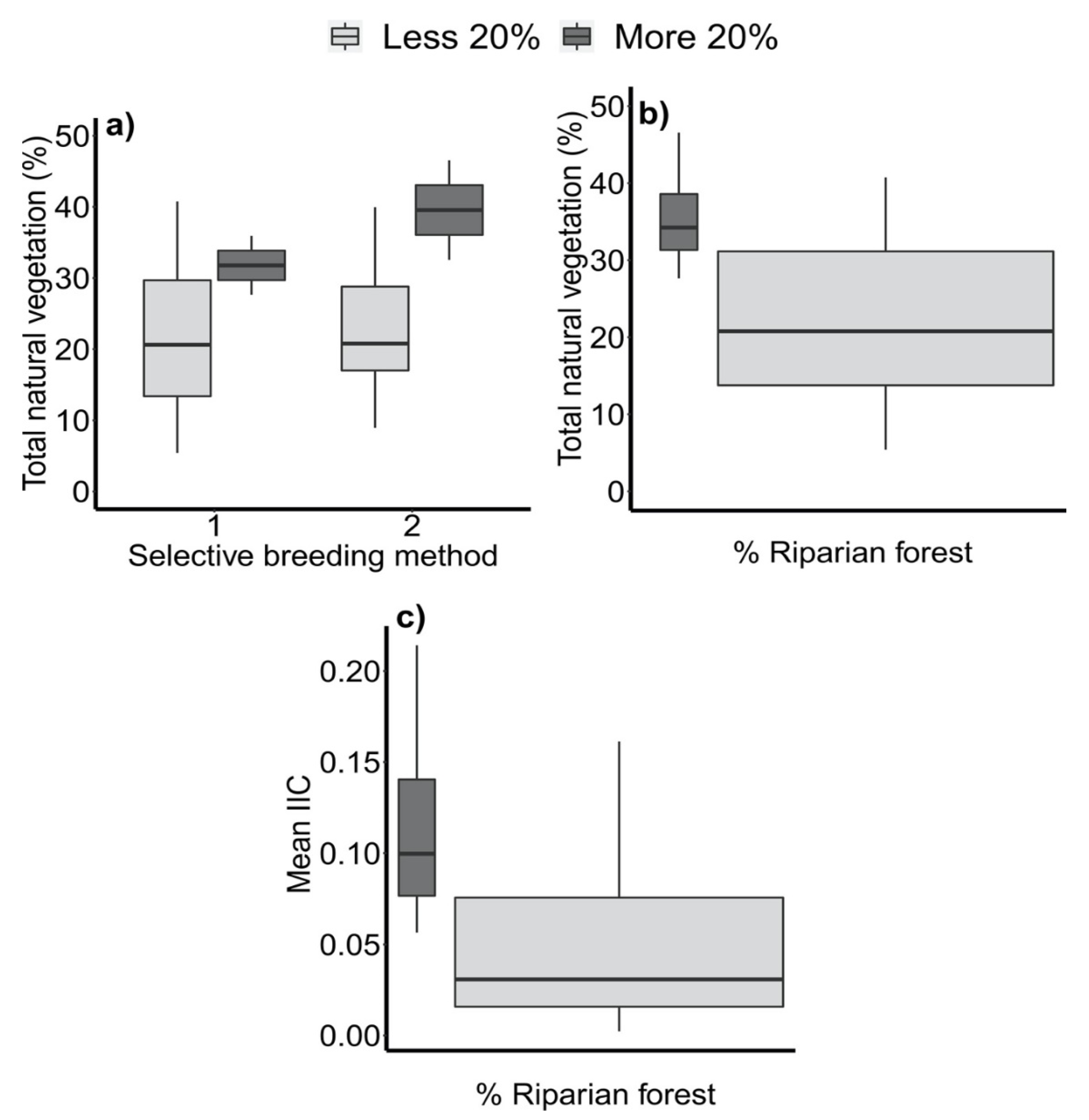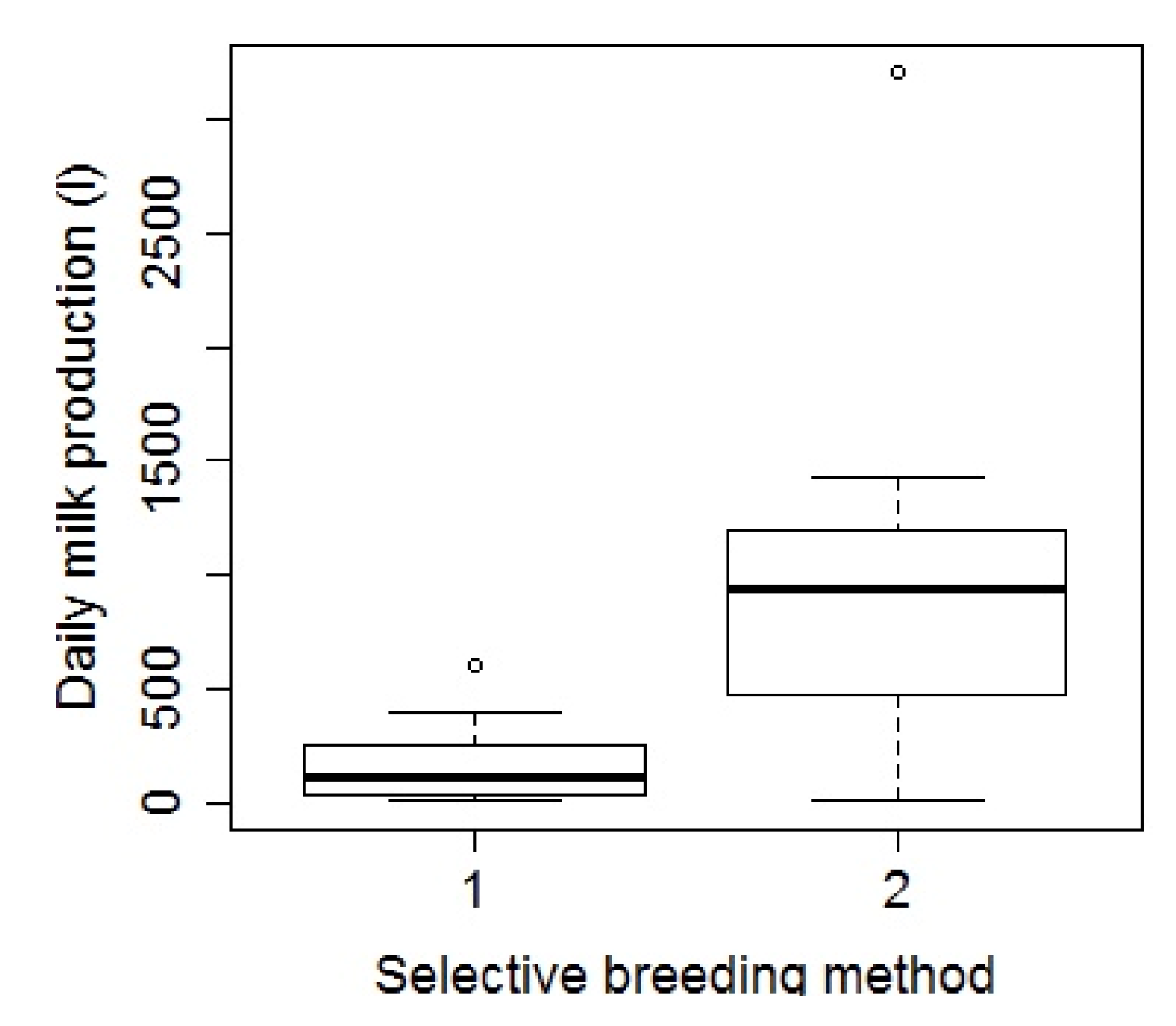Technification in Dairy Farms May Reconcile Habitat Conservation in a Brazilian Savanna Region
Abstract
1. Introduction
2. Materials and Methods
2.1. Study Area
2.2. Technification Variables and Farm Characteristics
2.3. Environment Feature Variables
2.4. Conservation Status of the Dairy Farms
2.5. Statistical Analyses
3. Results
3.1. Dairy Farm Characteristics
3.2. Technification and Conservation Status
3.3. Environment Features and Conservation Status
4. Discussion
5. Concluding Remarks
Supplementary Materials
Author Contributions
Funding
Institutional Review Board Statement
Informed Consent Statement
Data Availability Statement
Acknowledgments
Conflicts of Interest
References
- Johnson, C.N.; Balmford, A.; Brook, B.W.; Buettel, J.C.; Galetti, M.; Guangchun, L.; Wilmshurst, J.M. Biodiversity losses and conservation responses in the Anthropocene. Science 2017, 356, 270–275. [Google Scholar] [CrossRef]
- Laurance, W.F.; Sayer, J.; Cassman, K.G. Agricultural expansion and its impacts on tropical nature. Trends Ecol. Evol. 2014, 29, 107–116. [Google Scholar] [CrossRef]
- Newbold, T.; Hudson, L.N.; Hill, S.L.L.; Contu, S.; Lysenko, I.; Senior, R.A.; Börger, L.; Bennett, D.J.; Choimes, A.; Collen, B.; et al. Global effects of land use on local terrestrial biodiversity. Nature 2015, 520, 45–50. [Google Scholar] [CrossRef]
- FAO. The State of the World’s Biodiversity for Food and Agriculture; Bélanger, J., Pilling, D., Eds.; FAO: Rome, Italy, 2019; ISBN 978-92-5-131270-4. [Google Scholar]
- Goldewijk, K.K. Estimating global land use change over the past 300 years: The HYDE database. Glob. Biogeochem. Cycles 2001, 15, 417–433. [Google Scholar] [CrossRef]
- Hurtt, G.C.; Chini, L.P.; Frolking, S.; Betts, R.A.; Feddema, J.; Fischer, G.; Fisk, J.P.; Hibbard, K.; Houghton, R.A.; Janetos, A.; et al. Harmonization of land-use scenarios for the period 1500–2100: 600 years of global gridded annual land-use transitions, wood harvest, and resulting secondary lands. Clim. Chang. 2011, 109, 117–161. [Google Scholar] [CrossRef]
- LEAP Environmental Performance of Large Ruminant Supply Chains: Guidelines for Assessment. Draft for Public Review. Livestock Environmental Assessment and Performance (LEAP) Partnership. Available online: http://www.fao.org/3/a-bl094e.pdf (accessed on 17 May 2021).
- Alexandratos, N.; Bruinsma, J. World Agriculture towards 2030/2050: The 2012 Revision. Available online: http://www.fao.org/3/a-ap106e.pdf (accessed on 17 May 2021).
- Clegg, C.D. Impact of cattle grazing and inorganic fertiliser additions to managed grasslands on the microbial community composition of soils. Appl. Soil Ecol. 2006, 31, 73–82. [Google Scholar] [CrossRef]
- Kolbek, J.; Alves, R.J.V. Impacts of cattle, fire and wind in rocky savannas, southeastern Brazil. Acta Univ. Carolinae Environ. 2008, 22, 111–130. [Google Scholar]
- Burt, C.; Bachoon, D.S.; Manoylov, K.; Smith, M. The impact of cattle farming best management practices on surface water nutrient concentrations, faecal bacteria and algal dominance in the Lake Oconee watershed. Water Environ. J. 2012, 27, 207–215. [Google Scholar] [CrossRef]
- Conroy, E.; Turner, J.N.; Rymszewicz, A.; O’Sullivan, J.J.; Bruen, M.; Lawler, D.; Lally, H.; Kelly-Quinn, M. The impact of cattle access on ecological water quality in streams: Examples from agricultural catchments within Ireland. Sci. Total Environ. 2016, 547, 17–29. [Google Scholar] [CrossRef]
- De Boer, I.J.M.; Cederberg, C.; Eady, S.; Gollnow, S.; Kristensen, T.; Macleod, M.; Meul, M.; Nemecek, T.; Phong, L.T.; Thoma, G.; et al. Greenhouse gas mitigation in animal production: Towards an integrated life cycle sustainability assessment. Curr. Opin. Environ. Sustain. 2011, 3, 423–431. [Google Scholar] [CrossRef]
- Gerber, P.J.; Steinfeld, H.; Henderson, B.; Mottet, A.; Opio, C.; Dijkman, J.; Falcucci, A.; Tempio, G. Tackling Climate Change through Livestock—A Global Assessment of Emissions and Mitigation Opportunities; FAO: Rome, Italy, 2013. [Google Scholar]
- Perfecto, I.; Vandermeer, J. Biodiversity conservation in tropical agroecosystems: A new conservation paradigm. Ann. N. Y. Acad. Sci. 2008, 1134, 173–200. [Google Scholar] [CrossRef]
- Kok, A.; de Olde, E.M.; de Boer, I.J.M.; Ripoll-Bosch, R. European biodiversity assessments in livestock science: A review of research characteristics and indicators. Ecol. Indic. 2020, 112, 105902. [Google Scholar] [CrossRef]
- Alkemade, R.; Reid, R.S.; Van Den Berg, M.; De Leeuw, J.; Jeuken, M. Assessing the impacts of livestock production on biodiversity in rangeland ecosystems. Proc. Natl. Acad. Sci. USA 2013, 110, 20900–20905. [Google Scholar] [CrossRef]
- Broom, D.M.; Galindo, F.A.; Murgueitio, E. Sustainable, efficient livestock production with high biodiversity and good welfare for animals. Proc. R. Soc. B Biol. Sci. 2013, 280. [Google Scholar] [CrossRef]
- Parente, L.; Mesquita, V.; Miziara, F.; Baumann, L.; Ferreira, L. Assessing the pasturelands and livestock dynamics in Brazil, from 1985 to 2017: A novel approach based on high spatial resolution imagery and Google Earth Engine cloud computing. Remote Sens. Environ. 2019, 232, 111301. [Google Scholar] [CrossRef]
- Nogueira, S.F.; Macedo, M.C.M.; Poccard-Chapuis, R.; Da Silva, G.B.S.; Victoria, D.C.; Andrade, R.G.; Aguiar, D.A.; Bolfe, E.L. Geotechnologies for monitoring pasture degradation levels in Brazil. In A Produção Animal Frente às Mudanças Climáticas e Tecnológicas, Proceedings of the 51 Reunião Anual Da Sociedade Brasileira De Zootecnia, Barra dos Coqueiros, Brazil, 19 December 2014; Sociedade Brasileira de Zootecnia: Barra dos Coqueiros, Brazil, 2014. [Google Scholar]
- Latawiec, A.E.; Strassburg, B.B.N.; Valentim, J.F.; Ramos, F.; Alves-Pinto, H.N. Intensification of cattle ranching production systems: Socioeconomic and environmental synergies and risks in Brazil. Animal 2014, 8, 1255–1263. [Google Scholar] [CrossRef]
- Strassburg, B.B.N.; Latawiec, A.E.; Barioni, L.G.; Nobre, C.A.; da Silva, V.P.; Valentim, J.F.; Vianna, M.; Assad, E.D. When enough should be enough: Improving the use of current agricultural lands could meet production demands and spare natural habitats in Brazil. Glob. Environ. Chang. 2014, 28, 84–97. [Google Scholar] [CrossRef]
- Scaramuzza, C.A.d.M.; Sano, E.E.; Adami, M.; Bolfe, E.L.; Coutinho, A.C.; Esquerdo, J.C.D.M.; Maurano, L.E.P.; Narvaes, I.S.; Oliveira Filho, F.J.B.; Rosa, R.; et al. Land-Use and Land-Cover Mapping of the Brazilian Cerrado Based Mainly on Landsat-8 Satellite Images. Rev. Bras. Cartogr. 2017, 69, 1041–1051. [Google Scholar]
- Sano, E.E.; Rosa, R.; Scaramuzza, C.A.d.M.; Adami, M.; Bolfe, E.L.; Coutinho, A.C.; Esquerdo, J.C.D.M.; Maurano, L.E.P.; Narvaes, I.d.S.; Filho, F.J.B.d.O.; et al. Land use dynamics in the Brazilian Cerrado in the period from 2002 to 2013. Pesqui. Agropecuária Bras. 2019, 54. [Google Scholar] [CrossRef]
- Myers, N.; Mittermeier, R.A.; Mittermeier, C.G.; da Fonseca, G.A.B.; Kent, J. Biodiversity hotspots for conservation priorities. Nature 2000, 403, 853–858. [Google Scholar] [CrossRef] [PubMed]
- De Sy, V.; Herold, M.; Achard, F.; Beuchle, R.; Clevers, J.G.P.W.; Lindquist, E.; Verchot, L. Land use patterns and related carbon losses following deforestation in South America. Environ. Res. Lett. 2015, 10. [Google Scholar] [CrossRef]
- Pereira, O.J.R.; Ferreira, L.G.; Pinto, F.; Baumgarten, L. Assessing pasture degradation in the Brazilian Cerrado based on the analysis of MODIS NDVI time-series. Remote Sens. 2018, 10, 1761. [Google Scholar] [CrossRef]
- De Oliveira Silva, R.; Barioni, L.G.; Queiroz Pellegrino, G.; Moran, D. The role of agricultural intensification in Brazil’s Nationally Determined Contribution on emissions mitigation. Agric. Syst. 2018, 161, 102–112. [Google Scholar] [CrossRef]
- Oliveira, C.A.; Millen, D.D. Survey of the nutritional recommendations and management practices adopted by feedlot cattle nutritionists in Brazil. Anim. Feed Sci. Technol. 2014, 197, 64–75. [Google Scholar] [CrossRef]
- Costa, J.H.C.; Hötzel, M.J.; Longo, C.; Balcão, L.F. A survey of management practices that influence production and welfare of dairy cattle on family farms in southern Brazil. J. Dairy Sci. 2013, 96, 307–317. [Google Scholar] [CrossRef] [PubMed]
- Balcão, L.F.; Longo, C.; Costa, J.H.C.; Uller-Gómez, C.; Filho, L.C.P.M.H.; Hötzel, M.J. Characterisation of smallholding dairy farms in southern Brazil. Anim. Prod. Sci. 2017, 57, 735–745. [Google Scholar] [CrossRef]
- Latawiec, A.E.; Strassburg, B.B.N.; Silva, D.; Alves-Pinto, H.N.; Feltran-Barbieri, R.; Castro, A.; Iribarrem, A.; Rangel, M.C.; Kalif, K.A.B.; Gardner, T.; et al. Improving land management in Brazil: A perspective from producers. Agric. Ecosyst. Environ. 2017, 240, 276–286. [Google Scholar] [CrossRef]
- Latrubesse, E.M.; Arima, E.; Ferreira, M.E.; Nogueira, S.H.; Wittmann, F.; Dias, M.S.; Dagosta, F.C.P.; Bayer, M. Fostering water resource governance and conservation in the Brazilian Cerrado biome. Conserv. Sci. Pract. 2019, 1, 1–8. [Google Scholar] [CrossRef]
- Dias-Filho, M.B. Diagnóstico das Pastagens no Brasil. Embrapa Amaz. Orient. 2014, 22. [Google Scholar] [CrossRef]
- Gillingham, K.; Rapson, D.; Wagner, G. The rebound effect and energy efficiency policy. Rev. Environ. Econ. Policy 2016, 10, 68–88. [Google Scholar] [CrossRef]
- Paul, C.; Techen, A.K.; Robinson, J.S.; Helming, K. Rebound effects in agricultural land and soil management: Review and analytical framework. J. Clean. Prod. 2019, 227, 1054–1067. [Google Scholar] [CrossRef]
- zu Ermgassen, E.K.H.J.; de Alcântara, M.P.; Balmford, A.; Barioni, L.; Neto, F.B.; Bettarello, M.M.F.; de Brito, G.; Carrero, G.C.; Florence, E.d.A.S.; Garcia, E.; et al. Results from on-the-ground efforts to promote sustainable cattle ranching in the Brazilian Amazon. Sustainability 2018, 10, 1301. [Google Scholar] [CrossRef]
- Steinfeld, H.; Wassenaar, T.; Jutzi, S. Livestock production systems in developing countries: Status, drivers, trends. Rev. Sci. Tech. l’OIE 2006, 25, 505–516. [Google Scholar] [CrossRef] [PubMed]
- Neto, M.C.; Campos, J.M.d.S.; de Oliveira, A.S.; Gomes, S.T. Identification and quantification of benchmarks of milk production systems in Minas Gerais1. Rev. Bras. Zootec. 2012, 41, 2279–2288. [Google Scholar] [CrossRef]
- de Andrade Ferrazza, R.; Lopes, M.A.; de Oliveira Prado, D.G.; de Lima, R.R.; Bruhn, F.R.P. Association between technical and economic performance indexes and dairy farm profitability. Rev. Bras. Zootec. 2020, 49. [Google Scholar] [CrossRef]
- Bargo, F.; Muller, L.D.; Delahoy, J.E.; Cassidy, T.W. Performance of high producing dairy cows with three different feeding systems combining pasture and total mixed rations. J. Dairy Sci. 2002, 85, 2948–2963. [Google Scholar] [CrossRef]
- Sairanen, A.; Khalili, H.; Virkajärvi, P. Concentrate supplementation responses of the pasture-fed dairy cow. Livest. Sci. 2006, 104, 292–302. [Google Scholar] [CrossRef]
- Gouvêa, F.L.R.; Cardozo, L.L.; Canal, J.; Troncarelli, M.Z.; Pantoja, J.C.F. A descriptive study of teat morphology, milking machine characteristics, and milking practices in a sample of Brazilian dairy herds. Livest. Sci. 2020, 241, 104196. [Google Scholar] [CrossRef]
- Candiotto, L.; Adelaide, D.; Elejalde, G. Milk quality in small farms from Southern Region of Brazil. Cienc. Rural 2020, 50, 1–5. [Google Scholar] [CrossRef]
- Giordano, J.O.; Kalantari, A.S.; Fricke, P.M.; Wiltbank, M.C.; Cabrera, V.E. A daily herd Markov-chain model to study the reproductive and economic impact of reproductive programs combining timed artificial insemination and estrus detection. J. Dairy Sci. 2012, 95, 5442–5460. [Google Scholar] [CrossRef] [PubMed]
- Taylor, P.D.; Fahrig, L.; Henein, K.; Merriam, G. Connectivity is a vital element of landscape structure. Oikos 1993, 68, 571–573. [Google Scholar] [CrossRef]
- Tischendorf, L.; Fahrig, L. On the usage and measurement of landscape connectivity. Oikos 2000, 90, 7–19. [Google Scholar] [CrossRef]
- Pascual-Hortal, L.; Saura, S. Comparison and development of new graph-based landscape connectivity indices: Towards the priorization of habitat patches and corridors for conservation. Landsc. Ecol. 2006, 21, 959–967. [Google Scholar] [CrossRef]
- Saura, S.; Torné, J. Conefor Sensinode 2.2: A software package for quantifying the importance of habitat patches for landscape connectivity. Environ. Model. Softw. 2009, 24, 135–139. [Google Scholar] [CrossRef]
- R Core Team. R: A Language and Environment for Statistical Computing; R Foundation for Statistical Computing: Vienna, Austria, 2019. [Google Scholar]
- Fox, J.; Weisberg, S. An R Companion to Applied Regression, 3rd ed.; SAGE: Newbury Park, CA, USA, 2019; ISBN 978-1544336473. [Google Scholar]
- Zuur, A.F.; Ieno, E.N.; Elphick, C.S. A protocol for data exploration to avoid common statistical problems. Methods Ecol. Evol. 2010, 1, 3–14. [Google Scholar] [CrossRef]
- Fox, J.; Monette, G. Generalized collinearity diagnostics. J. Am. Stat. Assoc. 1992, 87, 178–183. [Google Scholar] [CrossRef]
- Soares-Filho, B.; Rajão, R.; Macedo, M.; Carneiro, A.; Costa, W.; Coe, M.; Rodrigues, H.; Alencar, A. Cracking Brazil’s Forest Code. Science 2014, 344, 363–364. [Google Scholar] [CrossRef]
- dos Santos, G.; Bittar, C.M.M. A survey of dairy calf management practices in some producing regions in Brazil. Rev. Bras. Zootec. 2015, 44, 361–370. [Google Scholar] [CrossRef]
- Ranieri, V.E.L. Reservas Legais: Critérios para localização e aspectos de gestão. Ph.D. Thesis, Universidade de São Paulo, São Paulo, Brazil, 2004. [Google Scholar]
- Kleijn, D.; Bommarco, R.; Fijen, T.P.M.; Garibaldi, L.A.; Potts, S.G.; van der Putten, W.H. Ecological Intensification: Bridging the Gap between Science and Practice. Trends Ecol. Evol. 2019, 34, 154–166. [Google Scholar] [CrossRef]
- Weibull, A.-C.; Ostman, O.; Granqvist, A. Species richness in agroecosystems: The effect of landscape, habitat and farm management. Biodivers. Conserv. 2003, 12, 1335–1355. [Google Scholar] [CrossRef]
- Popescu, V.D.; Hunter, M.L. Clear-cutting affects habitat connectivity for a forest amphibian by decreasing permeability to juvenile movements. Ecol. Appl. 2011, 21, 1283–1295. [Google Scholar] [CrossRef] [PubMed]
- Concepción, E.D.; Díaz, M.; Kleijn, D.; Báldi, A.; Batáry, P.; Clough, Y.; Gabriel, D.; Herzog, F.; Holzschuh, A.; Knop, E.; et al. Interactive effects of landscape context constrain the effectiveness of local agri-environmental management. J. Appl. Ecol. 2012, 49, 695–705. [Google Scholar] [CrossRef]
- Donald, P.F.; Evans, A.D. Habitat connectivity and matrix restoration: The wider implications of agri-environment schemes. J. Appl. Ecol. 2006, 43, 209–218. [Google Scholar] [CrossRef]
- Lima, F.P.; Bastos, R.P. Perceiving the invisible: Formal education affects the perception of ecosystem services provided by native areas. Ecosyst. Serv. 2019, 40, 101029. [Google Scholar] [CrossRef]
- Gerosa, S.; Skoet, J. Milk availability Trends in production and demand and medium-term outlook. ESA Work. Pap. 2012, 1–40. [Google Scholar] [CrossRef]
- Batista, E.; Soares-Filho, B.; Barbosa, F.; Merry, F.; Davis, J.; Van Der Hoff, R.; Rajão, R.G. Large-scale pasture restoration may not be the best option to reduce greenhouse gas emissions in Brazil. Environ. Res. Lett. 2019, 14. [Google Scholar] [CrossRef]
- de Léis, C.M.; Cherubini, E.; Ruviaro, C.F.; Prudêncio da Silva, V.; do Nascimento Lampert, V.; Spies, A.; Soares, S.R. Carbon footprint of milk production in Brazil: A comparative case study. Int. J. Life Cycle Assess. 2015, 20, 46–60. [Google Scholar] [CrossRef]
- Lambin, E.F.; Meyfroidt, P. Global land use change, economic globalization, and the looming land scarcity. Proc. Natl. Acad. Sci. USA 2011, 108, 3465–3472. [Google Scholar] [CrossRef]
- Santos, J.S.; Feltran-Barbieri, R.; Fonte, E.S.; Balmford, A.; Maioli, V.; Latawiec, A.; Strassburg, B.B.N.; Phalan, B.T. Characterising the spatial distribution of opportunities and constraints for land sparing in Brazil. Sci. Rep. 2020, 10, 1–11. [Google Scholar] [CrossRef]




| Group | Variable | Possible Outcomes |
|---|---|---|
| Productivity | Daily milk production | Quantitative variable |
| Feed management | primary forage diet | (1) pasture-raised dairy (free grazing); (2) pasture-raised with rotational grazing; (3) semi-confinement; (4) confinement (compost Barn or free-stall) |
| fertilizer pasture management | (1) yes (use fertilizers); (2) no (do not use) | |
| time of supplementary feed | (1) everyday; (2) dry season; (3) random; (0) not applicable (do not provide supplementary feed) | |
| criterium to supplement | (1) do not use; (2) technical calculation; (3) productivity; (4) random; (0) not applicable | |
| add vitamins to supplement | (1) yes; (2) no | |
| Milking management | milking method | (1) full hand; (2) machine with bucket; (3) automatic machine |
| milking frequency | (1) once-a-day; (2) twice-a-day; (3) three times a day | |
| farm infrastructure for milking | (1) milking pit; (2) milking parlor with roof and cement floor; (3) milking parlor without roof or cement floor; (4) milking parlor without roof and cement floor; (5) without a specific place to milk | |
| Sanitary control | cleaning of udder before milking | (1) no cleaning; (2) water; (3) commercial sanitizer (pre-dipping) |
| CMT test (California Mastitis Test) | (1) weekly; (2) biweekly; (3) monthly; (4) do not perform; (5) eventually with the suspicious of the disease | |
| Genetics and breeding | breeding program for productivity improvement | (1) yes (perform breeding); (2) no |
| selective breeding method | (1) natural service with selected breeding bulls; (2) artificial insemination; (0) do not perform selective breeding | |
| pregnancy diagnosis | (1) ultrasound; (2) transrectal palpation; (3) do not perform | |
| Overall characteristics | Cattle breed composition | (1) holand; (2) gir; (3) girholand; (4) crossbred cattle |
| Pasture restoration during the last decade | (1) yes (perform); (2) no (do not perform) | |
| Milk cooling tank | (1) bulk milk tank; (2) farm milk tank; (3) not applicable (do not use milk tank) | |
| Milk quality-based payment | (1) yes; (2) no | |
| Management separating pregnant cows | (1) yes; (2) no |
| Model | df | Sum of Square | RSS | AIC | p |
|---|---|---|---|---|---|
| Breeding program for productivity improvement | 1 | 395.86 | 2996.4 | 125.66 | 0.059 * |
| Selective breeding method | 1 | 448.57 | 3049.1 | 126.09 | 0.046 ** |
| Daily milk production | 1 | 7.49 | 2608.1 | 122.19 | 0.789 |
| Model | df | Sum of Square | RSS | AIC | p |
|---|---|---|---|---|---|
| Percentage of natural vegetation | |||||
| Percentage of riparian forest | 1 | 1420.24 | 2652.5 | 124.61 | 1.198 × 10−5 ** |
| Size of rural property | 3 | 483.08 | 1715.3 | 109.71 | 0.041 ** |
| IIC | |||||
| Percentage of riparian forest | 1 | 0.0314 | 0.0603 | −142.66 | 1.851 × 10−5 * |
| Size of rural property | 3 | 0.0139 | 0.0429 | −155.16 | 0.019 * |
Publisher’s Note: MDPI stays neutral with regard to jurisdictional claims in published maps and institutional affiliations. |
© 2021 by the authors. Licensee MDPI, Basel, Switzerland. This article is an open access article distributed under the terms and conditions of the Creative Commons Attribution (CC BY) license (https://creativecommons.org/licenses/by/4.0/).
Share and Cite
dos Santos, J.S.; Miziara, F.; Fernandes, H.d.S.; Miranda, R.C.; Collevatti, R.G. Technification in Dairy Farms May Reconcile Habitat Conservation in a Brazilian Savanna Region. Sustainability 2021, 13, 5606. https://doi.org/10.3390/su13105606
dos Santos JS, Miziara F, Fernandes HdS, Miranda RC, Collevatti RG. Technification in Dairy Farms May Reconcile Habitat Conservation in a Brazilian Savanna Region. Sustainability. 2021; 13(10):5606. https://doi.org/10.3390/su13105606
Chicago/Turabian Styledos Santos, Juliana Silveira, Fausto Miziara, Hayla da Silva Fernandes, Renato Cezar Miranda, and Rosane Garcia Collevatti. 2021. "Technification in Dairy Farms May Reconcile Habitat Conservation in a Brazilian Savanna Region" Sustainability 13, no. 10: 5606. https://doi.org/10.3390/su13105606
APA Styledos Santos, J. S., Miziara, F., Fernandes, H. d. S., Miranda, R. C., & Collevatti, R. G. (2021). Technification in Dairy Farms May Reconcile Habitat Conservation in a Brazilian Savanna Region. Sustainability, 13(10), 5606. https://doi.org/10.3390/su13105606






